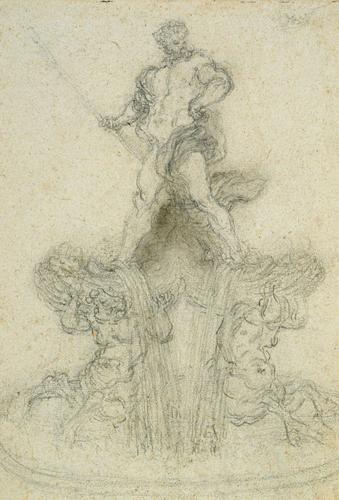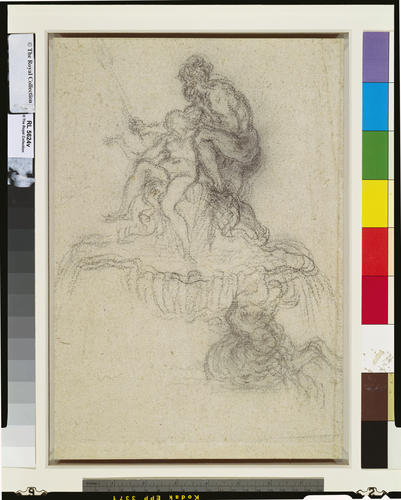A study for a fountain of Neptune 1652
Black chalk | 34.7 x 23.8 cm (sheet of paper) | RCIN 905624




-
Recto: a study for the central group in the Fountain of Neptune, Palazzo degli Estensi, Sassuolo (Modena). Verso: a design for the same fountain. See also RCIN 905627.
Bernini was called upon to produce far more sculpture than he could ever carve himself, and most works of his maturity were executed by others to his designs. This is a study for one of several fountains commissioned by Francesco d’Este for the courtyard of the Palazzo Ducale at Sassuolo, near Modena. The sea-god Neptune stands astride two shells supported by sea-centaurs. An assistant prepared clay models on the basis of Bernini’s drawings, from which local craftsmen executed the fountains in stucco.
Bernini was called upon to produce far more sculpture than he could ever carve himself, and most works from his maturity were carved by others to his designs. On both sides of this sheet are studies for a fountain commissioned by Duke Francesco d’ Este for the courtyard of the Palazzo Ducale at Sassuolo, 9 miles (15km) south of Modena. Bernini seems to have been approached about the project during the summer of 1652. That August, in a letter from Rome sent by the Duke’s agent, Bernini requested details about the layout of the palazzo; these were sent to him at the end of the month, and in September he provided a series of designs for the fountains.
Several drawings by Bernini survive for the project. The present sheet shows, on the recto, Neptune standing boldly astride two huge shells supported by sea-centaurs; on the verso, Neptune clambers over the acquiescent nymph Amphitrite, while a second sheet in the Royal Collection reverses the roles of Neptune and Amphitrite. In the Getty is a black-chalk drawing of a marine deity struggling with a dolphin, and a definitive pen-and-wash study of that design in the Victoria and Albert Museum may have been one of the drawings sent to the Duke for approval. Other studies of fountains have also been connected with the Sassuolo project, including a sheet in the British Museum, of a nymph reclining on a dolphin, and another in Berlin, of two tritons holding a gaping dolphin; but in the same year Bernini had been working on the design for the Fontana del Moro in Piazza Navona, and it is difficult to disentangle the spate of fountain designs from this period.
Bernini was then asked by the Duke to name the best sculptors in Rome, who might work on the project. From Bernini’s suggestions his assistant Antonio Raggi was chosen, but Raggi’s participation seems to have been limited to executing terracotta models (one of which survives in the Galleria Estense, Modena), from which local craftsmen executed the fountains rather limply in stucco. The Neptune stands at one side of the vestibule, and the pose of the god corresponds closely with the present study. Facing Neptune across the vestibule is a Galatea, an unresolved and inept figure that is surely not to Bernini’s designs. In a niche at the far side of the courtyard is the Marine God with a Dolphin; and now standing on the grand staircase, though perhaps intended for the centre of the courtyard, is a group of Neptune abducting Amphitrite, bearing little relationship to the playful figures seen in Bernini’s drawings.
Catalogue entry adapted from The Art of Italy in the Royal Collection: Renaissance and Baroque, London, 2007Provenance
Probably acquired by George III in 1762 as part of the collection of Cardinal Alessandro Albani; first recorded in a Royal Collection inventory of c.1810 (Inv. A, p. 114: 'Designs of Fountains in different parts near and at Rome')
-
Medium and techniques
Black chalk
Measurements
34.7 x 23.8 cm (sheet of paper)
Object type(s)








